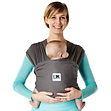U s a g e I n s t r u c t i o n

Soft Structured Carrier
T i p s on B a b y w e a r i n g
How close and snug should your baby be?
The great thing about babywearing is to be able to carry our baby close and snug. When done correctly, it takes the strain off our shoulders while providing a sense of security to the baby.
Parents who have just embarked on their babywearing journey may worry whether such a snug carry may cause discomfort to the baby? Let’s discuss some points about safe and comfortable babywearing in a ring sling.

* * * * * * * * * * * *
Point 1 :
The carrier should supports the baby in a position that mimics carrying with bare hands. Take note the height position of the hand supporting the baby's bottom. For newborns, the carrier that supports the baby's bottom may be a lot higher than the parent's waist. As such, for soft structured carrier, you may find the 'waist belt' may not be sitting on the parent's waist, but at a higher position to ensure baby is close enough to kiss.


Point 2 :
Sometimes, there may be slight pressure marks at the back of baby’s knee caused by the edge of the ring sling. By ensuring that baby’s bum is at a lower level than the knees when in a sling, baby will feel comfortable without pain – baby’s body weight will be resting on baby’s bum, and the knees only supports minimal weight from the legs.
Baby’s back should appear to be curved, in a C-shape. This is the optimal position for baby’s spinal development. The small space between baby and parent is comforting for the baby. Conversely, if baby’s back is forced to straighten, pressing hard on to the parent’s body, this will cause baby to feel discomfort.
.
* * * * * * * * * * * *
Good Example

Knee
Bum
Bad Example

Knee
Bum

Baby's back in a C-shaped curve, with weight supported at the bum.

The hands suppoting the neck and the bum of the baby presses the baby against the wearer, causing discomfort to the baby.
* * * * * * * * * * * *
Point 3 :
Let the baby lean their head naturally on the parent’s body. They may lean with their forehead or their cheek. Do not forcefully press them down, as this may block their nose and mouth, which would obstruct their breathing.
.

Side View
Top View
You should carry the baby at a height where you can kiss their forehead easily. This allows you to check your baby easily.

Point 4 :
Tighten the carrier to the point just before the wearer feels discomfort.
If the baby feels uncomfortable (e.g. too tight), they will let us know by crying.
If the carrier is not tighten snugly, the baby may slouch too much (more than the natural curve) in the carrier. As the baby slouch too much, baby’s head falls forward with the chin pressing against the chest, potentially blocking the airway. On the other hand, the distance between baby and parent shifts the centre of gravity forward, resulting in additional strain for the parent when carrying the baby.
* * * * * * * * * * * *
S a f e B a b y w e a r i n g

With permission and credit to UK Sling Consortium






